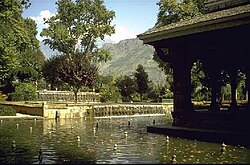
Mughal gardens are a group of gardens built by the Mughals in the Islamic style of architecture. This style was influenced by Persian gardens and Timurid gardens. Significant use of rectilinear layouts are made within the walled enclosures. Some of the typical features include pools, fountains and canals inside the gardens.
History
The founder of the Mughal empire, Babur described his favourite type of garden as a charbagh. This word developed a new meaning in India, because as Babur explains, India lacked the fast-flowing streams required for the Central Asian charbagh. The Agra garden, now known as the Ram Bagh, is thought to have been the first charbagh. India, Bangladesh and Pakistan have a number of Mughal gardens which differ from their Central Asian predecessors with respect to 'the highly disciplined geometry'. An early textual references about Mughal gardens are found in the memoirs and biographies of the Mughal emperors, including those of Babur, Humayun and Akbar. Later references are found from 'the accounts of India' written by various European travellers (Bernier for example). The first serious historical study of Mughal gardens was written by Constance Villiers-Stuart, with the title Gardens of the Great Mughals (1913). Her husband was a Colonel in Britain's Indian army. This gave her a good network of contacts and an opportunity to travel. During their residence at Pinjore Gardens, Mrs Villiers-Stuart also had an opportunity to direct the maintenance of an important Mughal garden. Her book makes reference to the forthcoming design of a garden in the Government House at New Delhi (now known as Rashtrapati Bhavan). She was consulted by Edwin Lutyens, and this may have influenced his choice of Mughal style for this project. Recent scholarly work on 'the history of Mughal gardens' has been carried out under the auspicious guidance of Dumbarton Oaks (including Mughal Gardens: Sources, Places, Representations, and Prospects edited by James L. Wescoat, Jr. and Joachim Wolschke-Bulmahn) and the Smithsonian Institution. Some examples of Mughal gardens are Shalimar Gardens (Lahore), Lalbagh Fort at Dhaka and Shalimar Gardens (Jammu and Kashmir).
From the beginnings of the Mughal Empire, the construction of gardens was a beloved imperial pastime. Babur, the first Mughal conqueror-king, had gardens built in Lahore and Dholpur. Humayun, his son, does not seem to have had much time for building – he was busy reclaiming and increasing the realm - however he is known to have spent a great deal of time at his father’s gardens. Akbar built several gardens first in Delhi, then in Agra, Akbar’s new capital. These tended to be riverfront gardens rather than the fortress gardens that his predecessors built. Building riverfront rather than fortress gardens influenced later Mughal garden architecture considerably. Akbar’s heir, Jahangir, did not build as much, but he helped to lay out the famous Shalimar garden and was known for his great love for flowers. Indeed, his trips to Kashmir are believed to have begun a fashion for naturalistic and abundant floral design.
Jahangir's son, Shah Jahan, marks the apex of Mughal garden architecture and floral design. He is famous for the construction of the Taj Mahal, a sprawling funereal paradise in memory of his favorite wife, Mumtaz Mahal.He is also responsible for the Red Fort at Delhi which contains the Mahtab Bagh, a night garden that was filled with night-blooming jasmine and other pale flowers.The pavilions within are faced with white marble to glow in the moonlight. This and the marble of the Taj Mahal are inlaid with semiprecious stone depicting scrolling naturalistic floral motifs, the most important being the tulip, which Shah Jahan adopted as a personal symbol.
The Mughals were obsessed with symbol and incorporated it into their gardens in many ways. The standard Quranic references to paradise were in the architecture, layout, and in the choice of plant life; but more secular, including numerological and zodiacal significances connected to family history or other cultural significance were often juxtaposed. The numbers eight and nine were considered auspicious by the Mughals and can be found in the number of terraces or in garden architecture such as octagonal pools.
Mughal garden design derives primarily from the medieval Islamic garden, although there are nomadic influences that come from the Mughals’ Turkish-Mongolian ancestry. Julie Scott Meisami describes the medieval Islamic garden as, “a hortus conclusus, walled off and protected from the outside world; within, its design was rigidly formal, and its inner space was filled with those elements that man finds most pleasing in nature. Its essential features included running water (perhaps the most important element) and a pool to reflect the beauties of sky and garden; trees of various sorts, some to provide shade merely, and others to produce fruits; flowers, colorful and sweet-smelling; grass, usually growing wild under the trees; birds to fill the garden with song; the whole cooled by a pleasant breeze. The garden might include a raised hillock at the center, reminiscent of the mountain at the center of the universe in cosmological descriptions, and often surmounted by a pavilion or palace.” The Turkish-Mongolian elements of the Mughal garden are primarily related to the inclusion of tents, carpets and canopies reflecting nomadic roots. Tents indicated status in these societies, so wealth and power were displayed through the richness of the fabrics as well as by size and number.
Sites of Mughal gardens
Afghanistan
India
- Humayun's Tomb- Delhi (Nizamuddin)
- Taj Mahal - Agra
- Ram Bagh - Agra
- Mehtab Bagh - Agra
- Safdarjung's Tomb
- Shalimar Gardens (Kashmir)- Kashmir
- Nishat Gardens - Kashmir
- Yadvindra Gardens- Pinjore
- Khusro Bagh, Allahabad
- Roshanara Bagh
Pakistan
- Shalimar Gardens (Kashmir)- Kashmir
- Nishat Gardens - Kashmir
- Chauburji (The Gate to the Mughal Gardens)
- Lahore Fort
- Shahdara Bagh
- Shalimar Gardens (Lahore)
- Hazuri Bagh
- Hiran Minar (Sheikhupura)
- Mughal Garden Wah
- Vernag




0 Comments:
Post a Comment